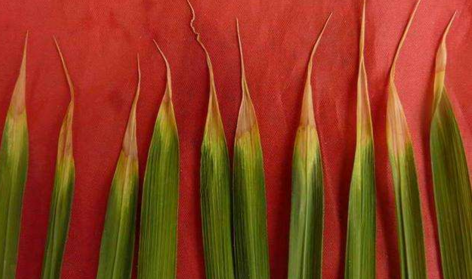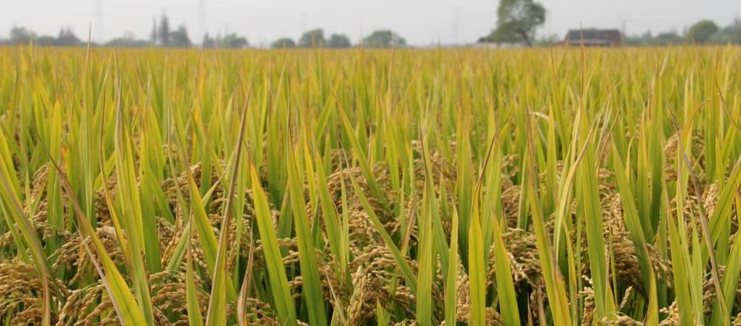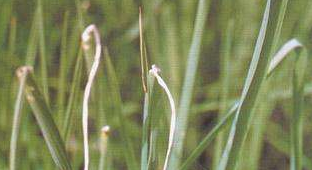1, symptom performance Rice stem nematode disease is mainly transmitted through rice seedlings, and it is collectively referred to as rice seedling disease. The nematode survives between the rice husk and the rice grain. After sowing and germination, the nematode is drilled from the bud sheath, attached to the growth point of the rice, the leaf bud and the extraneous tip of the newborn, and the needle is inserted into the cell to suck the juice, rice. After heading, it is transferred to the inside and outside of the young panicle, and then winters in the rice grain. (1) Typical symptoms: The rice can be harmed throughout the growth period, mainly affecting the leaves and grains, and the symptoms are most obvious at the booting stage. The leaves are dry and twisted. At the tip of the blade, there are dry and dry symptoms of grayish white and dry, and the twist is a rope head. The junction of the diseased and healthy tissues is obvious, but the junction of the special varieties is not obvious. Spikelets, small grains. Most of the diseased plants are normally heading and fruiting, but the ear is small, the grain is small, the grain size is increased, and the 1000-grain weight is reduced; the full-bodied grain hull is loose and open, slightly brown. Only the special varieties have difficulty in heading. (2) Significant period: no symptoms appear in the tillering and jointing stages of rice, and the symptoms in the seedling stage are generally not obvious (some of the seedlings have symptoms in 4 to 5 true leaves), and the booting stage is the peak of the peak. Distortion is especially noticeable, and the symptoms of severe attack at the ear stage are obvious. (3) Hidden phenomenon: It is worth noting that although the damage caused by dry worm disease is sometimes difficult to see (dry or spike) symptoms in rice leaves or ears, it still exists in rice plants. More nematodes make the rice plants weaker and the yield is reduced. It has been reported that three-quarters of the rice tillers infected by the dry-pointed nematode do not show symptoms, that is, hidden diseases. 2, the law of occurrence (1) Biological characteristics of nematodes: Rice stem-tailed nematodes can endure dryness, and nematodes exist in a dormant state in rice husks. They survive for 30 days in moist rice husks and 2-3 years in dry rice husks, but only survive for 4 months on rice husks remaining in rice fields and cannot survive in soil. The larvae or adult worms lurk between the husks of the grain and the rice grains. Long-distance transmission is mainly completed with the seed transfer. Most of the diseased worms survived overwintering in the full rice grains, accounting for 83%-88% of the total number of worms, but less in the glutinous rice. Indoor microscopy can crush the rice husks with hazelnuts, or cut the growth point of the rice seedlings, put a small amount of water on the surface dish, and the nematodes freed on them can be observed by 12~25 times anatomical mirror. It is linear. (2) Law of activity: When soaking seeds and germination, the nematodes in the disease resuscitate, freed into the water, invading the young shoots, invading from the gaps of the sprouts, and can also be transmitted from the diseased seedlings to the healthy seedlings, and the insects are attached to the growth points or leaf buds. In the tissue of the young and young leaves, the tissue juice is sucked and gradually moved upwards with the growth of the rice plants. During the booting stage, the nematodes are concentrated in the inside and outside of the young panicles, and can be transferred to the adjacent healthy plants with the irrigation water. It feeds on the growth point of rice and feeds it, causing shrinkage and distortion of the flag leaves around the inflorescence. This causes the inflorescence to be hidden in the primordium without stretching out, or the inflorescence becomes smaller, or the rice grains become smaller and the number of grains is reduced. This is the reason why the symptoms of dry tip at the booting stage are most obvious. (3) Degree of damage: The degree of infestation of rice of different varieties is also different. In the susceptible varieties, the yield loss can be 20%-50%, while in resistant varieties it is less than 20%. 3, prevention and control measures : pesticide soaking is the most critical, most effective and most effective prevention and control measures for the transmission of diseases. Once the disease occurs in Datian, other remedial measures often have little effect. 16% sputum clearing (4% chlorpyrifos + 12% prochloraz) 400-700 times, soaking seeds 48 (temperature higher than 23 ° C) -60 (temperature low 18-20 ° C) hours. After soaking, do not need to rinse with water, drench the water directly for seed dressing or sowing. Canned Apsaragus Spears,Apsaragus Spears Canned,Apsaragus Spears Tin,Apsaragus Canned Spears ZHANGZHOU TAN CO. LTD. , https://www.zztancan.com

